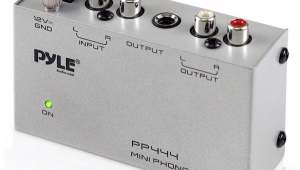Boulder 2008 phono preamplifier & 2010 preamplifier
I passed Boulder Amplifiers' CES room maybe 50 times, but all that came to mind was the time I'd visited Boulder, Colorado (where the company is based) in the early '70s and everyone was wearing plaid shirts, hauling backpacks, munching granola, and walking with that strange Boulder shuffle, where your feet never lose contact with the ground.
Now that I've spent a month with the 2008 $29,000 phono section and the 2010 $36,000 preamplifier, my thoughts about Boulder are different. I'd originally intended to review only the phono section, but when they told me how reasonably priced the preamp was, I said, "Oh, what the hell, you might as well throw that in too."
You could buy a nice car for $29,000, and a really nice car for $36,000—unless, of course, you can easily afford phono section and preamp, in which case you'd probably consider a $36,000 car an economy model. As you read about this ridiculously priced gear, keep in mind that, to "six-nines" percent (99.9999%) of the world's population, spending more than a few hundred dollars for a complete stereo is ridiculous. To most of them, you are ridiculous for carrying on about audio the way I know you do.
I went to Boulder's website and e-mailed Bruce Van Allen, who's listed as the person to contact, and asked if I might review the 2008 phono preamp, about which I knew nothing. I hadn't even read reviews of Boulder products. "I live in the real world," I'd say to myself. "I've got better things to do than read reviews of ridiculously priced audio gear."
But the audacity of charging $29,000 for a phono stage got the best of me. I own one that retailed for $7000, and that struck me as ridiculous—even though I still think it's worth the money. Could the 2008 be 22,000 dollars' worth better? Was it better at all?
I had to find out.
Boulder 2008 balanced phono preamplifier
Look but Don't Listen: Not many days after I'd contacted him, Bruce Van Allen showed up at my door with some boxes. His attitude as he unpacked them was reminiscent of a dealer in illicit substances who just knows that what he's about to lay out on the table will leave an impression. All I was getting this visit was a visual and a backgrounder--Van Allen was on a road trip, and the 2008 and the 2010 were on their way to Goodwin's, in Boston. The plan was for the store to ship them down to me at the beginning of April so that I could listen for a month.

For reasons I eventually came to understand, when the end of March came 'round, Goodwin's didn't want to let go of the Boulder units. But eventually they relented, and the cartons showed up at my garage door. I ignored the preamp and headed directly for the phono section and its outboard power supply. The weight of the surprisingly heavy power supply (actually, three entirely independent supplies in one chassis) is skewed toward the front by three massive toroidal transformers, which makes it awkward to handle. Its luxuriously finished, satin-smooth, champagne-gold faceplate makes it clear that this is one power supply that's meant to be seen. The preamp, with its row of mirror-smooth pushbuttons, was even more enticing.
The 2008 has two RCA jacks for a moving-coil-cartridge demagnetizer, which the unit can automatically inject at the push of a button. Other than those, there's not an RCA in sight—the phono section and preamp are fully balanced designs. So before listening to $29,000 worth of phono section, I needed both in and out RCA-XLR adapters. I had a DIN-XLR set of Cardas Neutral Cross phono cables, which I used with the Graham 2.2 tonearm. I used a pair of adapters for the Immedia RPM-2 tonearm, and another pair to get the output to the single-ended Hovland HP-100 preamp.
For $29,000 you get tremendous convenience and flexibility. There are three balanced inputs. Associated with each input is a rear-mounted pull-out "personality card" with triple DIP switches. These allow you to choose between (and are labeled) MM or MC, Hi Gain or Lo Gain, and Demag or No Demag, depending on whether you're using an MC or MM cartridge into that input. The default load into MM is the standard 47k ohms, and 1k ohm into MC. One input's cards came with 100 ohm resistors soldered in.
- Log in or register to post comments

















































